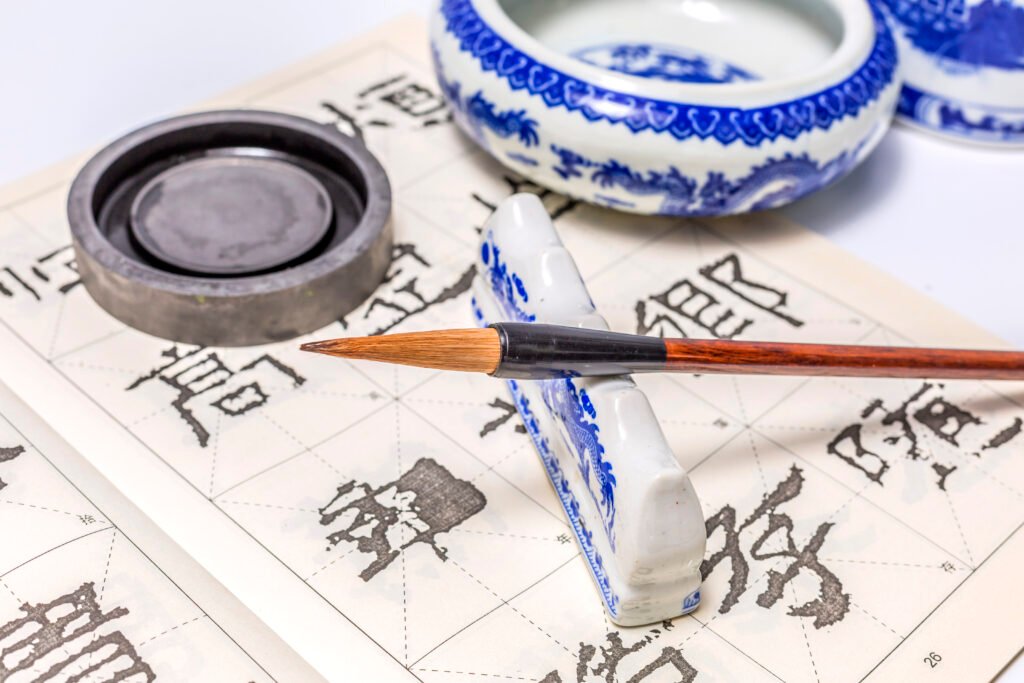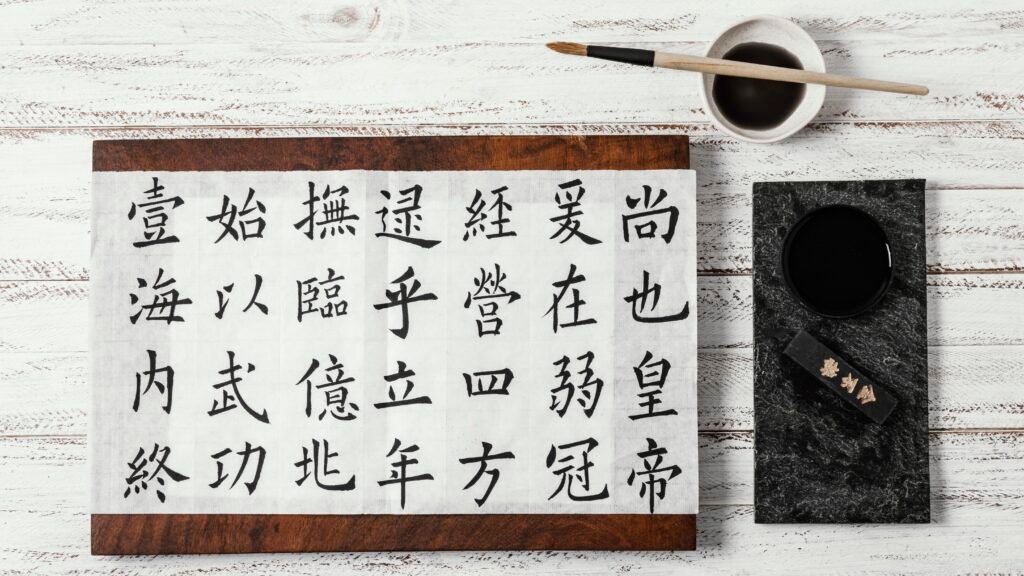Chinese art calligraphy is one of the most profound and enduring forms of artistic expression in Chinese culture. Beyond being a method of writing, it is a visual art that embodies centuries of history, philosophy, and aesthetic principles. Each stroke carries meaning, rhythm, and emotion, transforming simple characters into works of art that reflect the personality, skill, and moral character of the artist. At China Art Hub, we celebrate this rich tradition, offering insights, resources, and guidance for enthusiasts, collectors, and aspiring calligraphers.
From the earliest inscriptions on oracle bones to the refined brushwork of famous masters like Wang Xizhi and Yan Zhenqing, famous chinese calligraphy has evolved through dynasties, blending tradition with innovation. Today, it continues to influence modern art, design, and even commercial branding, bridging the gap between classical heritage and contemporary creativity.
Whether you are exploring calligraphy as an art form, learning its techniques, or appreciating its cultural significance, understanding its history, styles, and practical applications is essential. This comprehensive guide will help you navigate the world of Chinese art calligraphy, providing knowledge and inspiration for both study and practice.
Table of Contents
Understanding Chinese Art Calligraphy
Chinese art calligraphy is a unique blend of visual art and written expression, where each stroke carries meaning, emotion, and cultural depth. It reflects not only the skill of the artist but also their personality, discipline, and connection to centuries of Chinese tradition.
What is Chinese Calligraphy?
Chinese calligraphy, or shufa, is the practice of writing Chinese characters with brush and ink in an artistic manner. Every stroke is carefully controlled, conveying not only meaning but emotion, rhythm, and harmony. Calligraphy is both a visual art and a cultural practice that requires discipline, patience, and creativity.
Cultural Significance
Historically, calligraphy has played a central role in Chinese society. Scholars, government officials, and artists considered it an essential skill demonstrating intellect, moral character, and cultural refinement. Beyond aesthetics, calligraphy has been used in education, rituals, religious practices, and official documentation.
Calligraphy as an Art Form vs. Ordinary Writing
While ordinary writing is functional, calligraphy is artistic. Each character is carefully composed with attention to balance, proportion, and flow. Practicing calligraphy enhances mindfulness, cultivates patience, and deepens understanding of Chinese culture.
Role in Traditional Chinese Education
Classical education emphasized calligraphy as part of the Confucian curriculum. Students learned to write carefully and elegantly, reflecting discipline and moral development. Mastery of calligraphy was a mark of scholarship and cultural sophistication.
History of Chinese Calligraphy
The history of Chinese calligraphy stretches back thousands of years, tracing the evolution of written characters from ancient inscriptions to refined artistic forms. It reflects the cultural, philosophical, and aesthetic values of each era, shaping Chinese art and society over centuries.
Origins and Early Development
The earliest known Chinese writing appeared on oracle bones during the Shang dynasty (c. 1600–1046 BCE) and was primarily used for divination. During the Zhou dynasty, inscriptions on bronze vessels refined character forms, laying the foundation for formalized writing and artistic expression.
READ ALSO: Brushes for Chinese painting and calligraphy : Understanding Their Art and Purpose
Major Historical Periods
The Qin dynasty (221–206 BCE) standardized Chinese characters, unifying the empire’s written language. The Tang dynasty (618–907 CE) marked the golden age of calligraphy, with masters such as Ouyang Xun and Yan Zhenqing developing scripts still studied today. Song and Yuan dynasties emphasized expressive brush strokes, integrating literary and artistic pursuits, while the Ming and Qing dynasties saw diversification of styles and popularization among amateurs.
Famous Chinese Calligraphy Masters
- Wang Xizhi: Known as the Sage of Calligraphy, famous for the Lanting Xu, a masterpiece of flowing elegance.
- Yan Zhenqing: Celebrated for bold, spiritual strokes reflecting moral integrity.
- Ouyang Xun: Known for precision and disciplined structure, forming a foundation for classical training.
Famous Chinese Calligraphy Styles
Seal Script (Zhuanshu)
Seal script features rounded, symmetrical characters and is often seen in official seals and ceremonial inscriptions.
Clerical Script (Lishu)
Clerical script simplified strokes for practical use while maintaining elegance. Its techniques continue to influence modern calligraphy and decorative art.
Regular Script (Kaishu)
Regular script is widely used for learning and professional writing. Tang dynasty masterpieces in Kaishu are often referenced for study and exhibition.
Running Script (Xingshu)
Xingshu is semi-cursive, balancing readability and artistic freedom. Contemporary calligraphers use Xingshu in digital designs, branding, and decorative art.
Cursive Script (Caoshu)
Caoshu emphasizes expression, rhythm, and individuality. Modern adaptations appear in abstract art, creative design, and commercial projects.
Modern Chinese Calligraphy
Modern Chinese calligraphy blends traditional techniques with contemporary creativity, bringing new life to an ancient art form. Today, it is not only practiced for cultural appreciation but also applied in design, digital media, and commercial projects.
From Tradition to Contemporary Art
Modern Chinese calligraphy blends traditional methods with contemporary creativity. Artists incorporate calligraphy into digital art, branding, interior design, and global exhibitions.
Workshops and Learning Platforms
Online courses, workshops, and cultural institutions make calligraphy accessible to enthusiasts worldwide.
Influential Modern Artists
Contemporary calligraphers integrate traditional scripts with modern design aesthetics, inspiring art communities and commercial applications.
Calligraphy Tools and Techniques
Mastering Chinese calligraphy begins with understanding the essential tools and techniques that bring each character to life. From traditional brushes and ink to modern methods, the right tools and proper technique are the foundation of creating expressive, balanced strokes.
The Four Treasures of Study
- Brush: Soft, medium, and hard brushes suit different styles.
- Ink: Traditional ink sticks are manually ground for texture; liquid ink is convenient for beginners.
- Paper: Rice paper and Xuan paper influence stroke absorbency and final appearance.
- Inkstone: Ensures consistent, smooth ink flow.
Modern Tools
Digital tablets, styluses, and online kits allow for accessible practice and creative experimentation.
Drawing Techniques
Mastery of brush pressure, speed, and angle is crucial. Composition, spacing, and symbolic elements enhance visual impact.
Calligraphy as a Reflection of Character
Calligraphy is not just an art form; it is a mirror of the artist’s personality and inner world. Every stroke and curve reflects discipline, emotion, and the unique character of the person behind the brush.
Philosophical Roots
Calligraphy is influenced by Daoism (harmony and flow) and Confucianism (discipline and moral integrity).
Personality Expression
Stroke style, pressure, and movement reflect the artist’s temperament and emotions.
Meditative Practice
Calligraphy cultivates mindfulness, focus, and spiritual balance.
Aesthetic and Cultural Significance
Chinese calligraphy is not only a visual art but also a profound reflection of Chinese philosophy, culture, and values. Its beauty lies in the harmony of strokes, the balance of composition, and the deeper meaning conveyed through each character.
Integration in Painting and Decorative Arts
Calligraphy complements traditional Chinese painting and ornamentation.
Architectural Influence
Inscriptions on monuments, temples, and gardens convey cultural depth.
Garden Design and Ornamentation
Calligraphy integrates with landscapes, creating philosophical harmony.
Ritual and Ceremonial Contexts
Scrolls and ceremonial works preserve historical and religious traditions.

Learning Chinese Calligraphy
Learning Chinese calligraphy is a journey that combines patience, practice, and cultural appreciation. Whether you are a beginner or looking to refine your skills, understanding the fundamentals opens the door to mastering this timeless art.
Beginner’s Guide
Start with simple brushes, ink, and practice sheets. Repetition of foundational strokes develops control and confidence.
Intermediate Techniques
Explore semi-cursive and regular scripts with guided lessons.
Advanced Practices
Blend traditional techniques with personal expression and participate in exhibitions to showcase skills.
Commercial Applications of Calligraphy
Chinese calligraphy is not only a cherished art form but also a versatile tool in modern commercial and creative industries. From branding and product design to interior decor, it brings cultural elegance and artistic value to businesses and spaces.
Branding and Product Design
Calligraphy is used in logos, packaging, and marketing to convey sophistication and cultural authenticity.
Home and Interior Design
Wall scrolls, decorative panels, and framed calligraphy bring elegance and cultural depth.
Corporate Collaborations
Artists partner with brands for limited editions, workshops, and commercial projects.
Preserving Chinese Calligraphy Heritage
Preserving Chinese calligraphy is essential to maintaining the rich cultural and artistic legacy of China. Through museums, research, and digital archiving, this timeless art form continues to inspire and educate generations worldwide.
Museums and Exhibitions
Major institutions preserve historical scrolls and calligraphy artifacts.
Academic Research
Scholars study techniques, styles, and historical context for preservation.
Digital Archiving
Online platforms allow global access and ensure cultural continuity.
Educational Programs
Universities and cultural centers teach classical and modern calligraphy techniques.
Experiential Calligraphy
Experiential calligraphy offers a hands-on journey into the art of Chinese writing, allowing learners to connect directly with centuries of tradition. Through workshops, demonstrations, and cultural events, enthusiasts can immerse themselves in the techniques, philosophy, and beauty of calligraphy.
Workshops and Demonstrations
Hands-on experiences enhance learning and appreciation.
Festivals and Cultural Tourism
Participate in events to practice and observe calligraphy in cultural context.
Cultural Engagement
Festivals often include competitions, live demonstrations, and exhibitions.
Calligraphy in Modern Media
Calligraphy continues to inspire contemporary art and media, bridging traditional techniques with modern creativity. From digital design to film and social platforms, this ancient art form finds new expression in today’s visual culture.
Animation, Film, and Digital Art
Traditional scripts inspire storytelling and creative projects.
Social Media Influence
Platforms like Instagram, YouTube, and TikTok promote calligraphy trends and global exposure.
Online Communities
Enthusiasts share tutorials, critiques, and collaborate, supporting emerging artists.
Calligraphy Competitions and Communities
Calligraphy competitions and communities play a vital role in preserving and promoting Chinese art calligraphy. They provide platforms for artists to showcase their skills, connect with peers, and gain recognition both nationally and internationally. For more information visit here.
National and International Contests
Competitions encourage excellence and showcase emerging talent.
Online Communities
Global forums allow discussion, learning, and networking.
Supporting Emerging Artists
Mentorship, exhibitions, and collaborations nurture new talent.
Conclusion
Chinese art calligraphy is more than just an ancient form of writing; it is a living tradition that combines history, philosophy, and aesthetic mastery into a single art form. Through centuries of evolution, from the oracle bones of the Shang dynasty to the flowing scripts of modern masters, calligraphy has reflected the cultural values, moral principles, and artistic sensibilities of Chinese society. Its influence continues to extend beyond traditional art, inspiring contemporary design, digital media, branding, and home decor, making it relevant in both cultural and commercial contexts.
At China Art Hub, we recognize the enduring value of calligraphy and its role in connecting people with Chinese heritage. Whether you are a beginner learning brush techniques, an art enthusiast exploring famous works, or a professional seeking to incorporate calligraphy into design and branding, understanding its history, tools, and styles is essential. By practicing, studying, and appreciating Chinese calligraphy, you not only preserve a vital cultural legacy but also gain a medium for self-expression and creativity. Embracing this art form ensures that its timeless beauty and cultural significance continue to inspire generations to come.

